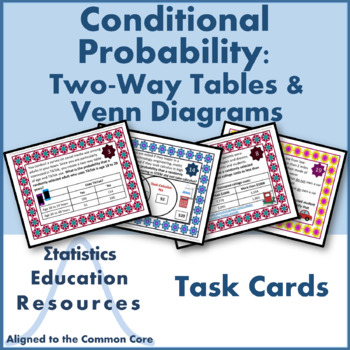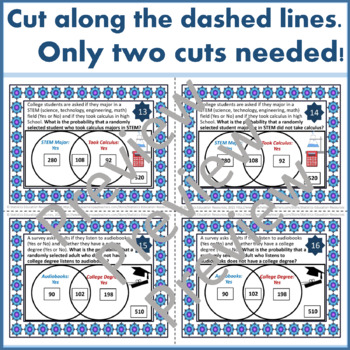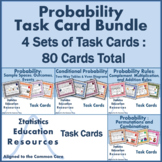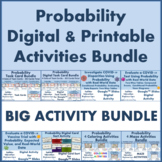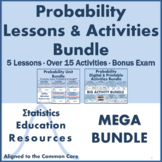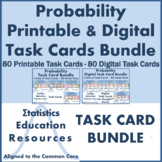Conditional Probability Task Cards: Two-Way Tables & Venn Diagrams (Common Core)
- PDF
What educators are saying
Also included in
- Probability Task Cards Bundle (80 Cards) (Common Core Aligned)This product is a bundle that includes 4 sets of Common Core-Aligned task cards (80 cards total) each with a recording sheet and answer key. These task cards only require two cuts per page! The sets of task cards can also be purchased a lPrice $7.49Original Price $10.00Save $2.51
- This BIG bundle includes multiple printable and digital probability activities aligned with Common Core standards. Students practice solving problems on sample spaces, conditional probability, probability rules, permutations, and combinations in these maze activities. Students use both computation aPrice $34.99Original Price $50.90Save $15.91
- This MEGA bundle includes 5 Common Core Aligned lessons, 1 mid-unit integrated mini-review and worksheet (as homework or a quiz!), and 1 exam with answer key, and over 15 printable and digital probability activities aligned with Common Core standards. Each lesson includes lecture slides with speakerPrice $46.99Original Price $73.35Save $26.36
- This task card bundle includes 4 sets of Common-Core aligned printable and digital task cards (80 printable and 80 digital task cards). Printable task cards are provided in sheets of four cards that only require 2 cuts. Digital task cards are created in Google™ Forms. This task card bundle is perfePrice $15.99Original Price $22.00Save $6.01
Description
Conditional Probability Task Cards: Two-Way Tables and Venn Diagrams (Common Core Aligned)
This product includes 20 task cards (4 cards per page):
8 cards on computing conditional probability from two-way tables
8 cards on computing conditional probability from Venn diagrams
4 cards on computing conditional probability using a model of one’s choice.
Task card questions range from introductory to advanced. This range helps struggling students learn and practice basic concepts while keeping accelerated students engaged. Questions emphasize interpretation and context of conditional probability as well as computation of conditional probability. A recording sheet and answer key are also included. Love task cards but hate cutting them out? Same here! These cards are created with 0.25 inch borders so that only two cuts are required! (Older printers may require three cuts). These cards are a great group activity for subs.
Looking for digital task cards for use with Google Classroom™? You can find them here.
About the task card border designs:
If you teach mathematics or statistics, there is a good chance that you enjoyed playing with Spirograph as a child. Spirograph is a toy that involves tracing a circle moving around either the inside or outside of a wheel, making beautiful designs. Well, these designs can also be made on a computer with graphing software and some trigonometric functions. Added bonus: no smudged ink or accidentally moving the paper! Although they aren’t statistical per se, these Spirograph-inspired designs are a great opportunity to convey the beauty of mathematics to students. Spirograph-inspired task card borders are available for purchase here.
We are pleased to feature clip art from some of your favorite TpT sellers:
• Water bottle © Educlips at https://www.teacherspayteachers.com/Store/Educlips
• Drink can © Luigi Clipart at https://www.teacherspayteachers.com/Store/Luigi-Clipart
• Piggy bank © Molly Tillyer at https://www.teacherspayteachers.com/Store/Molly-Tillyer
• Coins © Spot on First at https://www.teacherspayteachers.com/Store/Spot-On-First
• Science set © Surfer Kids Clip Art by Pieter Els at https://www.teacherspayteachers.com/Store/Surfer-Kids-Clip-Art
• Calculator and books © Studio Devanna at https://www.teacherspayteachers.com/Store/Studio-Devanna
• Smartphones © Creative to the Core at http://www.teacherspayteachers.com/Store/Creativetothecore
• Graduation clip art © Charlotte’s Clips at https://www.teacherspayteachers.com/Store/Charlottes-Clips-4150
• Cars © Speech Doodles at https://www.teacherspayteachers.com/Store/Speech-Doodles
• Old school TVs © The Mouse that Roared at https://www.teacherspayteachers.com/Store/The-Mouse-That-Roared
This product includes:
1) 20 task cards in PDF
2) A two-page recording sheet in PDF
3) A two-page answer key in PDF
Objectives:
1) Practice using the concept that conditional probability of A given B is P(A and B)/P(B).
2) Practice constructing two-way tables and using the tables to approximate conditional probabilities.
3) Practice recognizing and explaining the concept of conditional probability in everyday language and everyday situations.
4) Practice using Venn diagrams to describe events as subsets of a sample space (set of outcomes) as unions, intersections or complements of other events.
5) Practice finding the conditional probability of A given B as the fraction of B’s outcomes that also belong to A; interpret the answer in terms of a model.
Common Core Standards:
HSS.CP.A.3: Understand conditional probability of A given B as P(A and B)/P(B) and interpret independence of A and B as saying that the conditional prob of A given B is the same as the probability of A, and the conditional probability of B given A is the same as the probability of B
HSS.CP.A.4: Construct and interpret 2-way frequency tables of data when 2 categories are associated with each object being classified. Use the 2-way table as a sample space to decide if events are independent and to approximate conditional probabilities.
HSS.CP.A.5: Recognize and explain the concepts of conditional probability and independence in everyday language and situations.
HSS.CP.B.6: Find the conditional probability of A given B as the fraction of B’s outcomes that also belong to A; interpret the answer in terms of a model
About this product:
This purchase is to be used by one teacher only for classroom use. These materials may not be shared without purchasing the appropriate number of licenses. With the exception of remote learning, these materials may not be uploaded to the internet in any form (classroom websites, personal websites, or network drives, etc.).
Want more task cards or resources on related topics? Check these out!:
Probability Task Cards: Sample Spaces, Outcomes, & Events (Common Core Aligned)
Probability Rules Task Cards: Complement, Multiplication, Addition (Common Core)
Probability Task Cards: Permutations and Combinations (Common Core Aligned)
Distance Learning: Probability Digital Card Sort Activity (Common Core Aligned)
Distance Learning: Evaluate a COVID-19 Test using Probability with Real Data
Distance Learning: Investigate COVID-19 Disparities using Probability with Real Data
Bundle Distance Learning: Probability Unit Curriculum (Common Core)
Additional Tips:
Follow Statistics Education Resources on Pinterest! https://www.pinterest.com/statisticseducationresources/
Want to earn TeachersPayTeachers credit for future purchases?
1) Login and visit your ‘My Purchases’ page
2) Click the ‘Provide Feedback’ button.
3) Leave a rating and quick comment.
4) Your feedback will help in creating future products for the teaching community.
Want to be first to learn more about Statistics Education Resources products?
1) Look for the green star near the top of the page by the store name, Statistics Education Resources.
2) Click it to be first to know about my new products, freebies, and discounts!
© Statistics Education Resources, 2021
Disclaimers:
The National Governors Association Center for Best Practices and Council of Chief State School Officers are the sole owners and developers of the Common Core State Standards. © Copyright 2010. National Governors Association Center for Best Practices and Council of Chief State School Officers. All rights reserved. Spirograph is the trademark of Hasbro. © Hasbro. All rights reserved.
This product is the work of Statistics Education Resources. Claims of alignment with the Common Core State Standards are the personal opinion of Statistics Education Resources and do not necessarily reflect the official views of the National Governors Association Center for Best Practices and Council of Chief State School Officers. No association with or endorsement by the National Governors Association Center for Best Practices and Council of Chief State School Officers is intended or implied. Claims of inspiration by Spirograph are the opinion of Statistics Education Resources and do not necessarily reflect the official views of Hasbro. No association with or endorsement by Hasbro is intended or implied.

